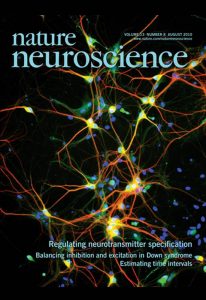The specific clinical hypothesis of Terraneo et al.6 arose directly from an experiment by Chen et al. in 2013.
 Rats that compulsively seek cocaine have been found to have lower activity in an area of the medial prefrontal cortex known as the prelimbic cortex than non–drug-seeking rats. When Chen et al. optogenetically stimulated prelimbic cortex in compulsive rats, their cocaine-seeking behavior decreased. Terraneo et al.6 adapted this approach to the clinical setting using a technique called transcranial magnetic stimulation (TMS). This noninvasive brain stimulation modality, approved for treatment of major depression in the US and in Europe8, employs strong, rapidly changing (millisecond timescale) magnetic fields arising from coiled wires positioned outside the head, which in turn induce electrical responses inside the brain.
Rats that compulsively seek cocaine have been found to have lower activity in an area of the medial prefrontal cortex known as the prelimbic cortex than non–drug-seeking rats. When Chen et al. optogenetically stimulated prelimbic cortex in compulsive rats, their cocaine-seeking behavior decreased. Terraneo et al.6 adapted this approach to the clinical setting using a technique called transcranial magnetic stimulation (TMS). This noninvasive brain stimulation modality, approved for treatment of major depression in the US and in Europe8, employs strong, rapidly changing (millisecond timescale) magnetic fields arising from coiled wires positioned outside the head, which in turn induce electrical responses inside the brain.
Terraneo et al. recruited 32 cocaine-addicted individuals to participate in this open study. Half of the participants were randomly allocated to rTMS therapy and the other half were allocated to a standard drug treatment (a cocktail of medications that have been used to treat symptoms of cocaine withdrawal). Although the study was brief, 69% of individuals in the rTMS-treated group remained drug-free during the initial treatment phase, compared with 19% of the control group (as tracked by urine drug tests). The rTMS group also reported significantly less cocaine craving. The difference between groups emerged early during the treatment: by day 12, 50% of the control group had already relapsed, whereas not a single member of the rTMS group had relapsed. A marker of naturalistic practicality was that no rTMS patients dropped out during the first month of treatment, whereas three participants were lost from the control group.
An important conclusion of the study was that stimulation of the DLPFC may suppress the compulsionof cocaine-addicted subjects to seek out cocaine.
The study by Terraneo et al. not only stirs new hope for principled interventional treatment of addiction, but also, more fundamentally, defines a new process for neuroscience.
A challenge for the future will be to optimize neuromodulation parameters for anatomical and temporal precision, minimally invasive access to deep brain regions, and strong safety and efficacy profiles that leverage the avalanche of insights emerging from the basic science laboratories. Meanwhile, fundamental laboratory research will continue to lay essential foundations for understanding the brain as a complex dynamical system and for probing the causal underpinnings of adaptive and maladaptive behaviors.
